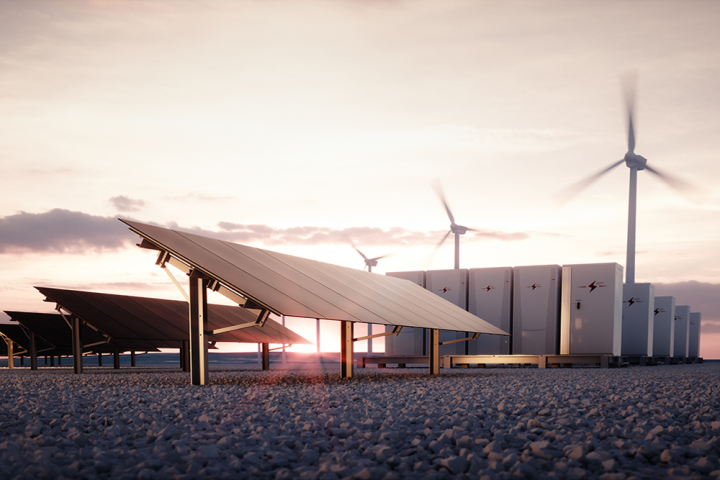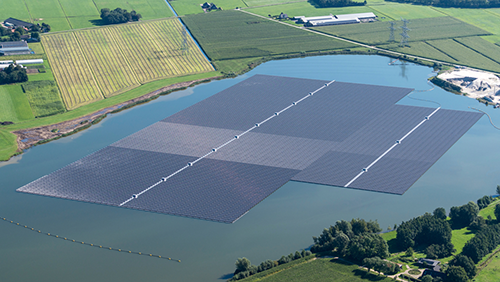
The sun shines on plastics
Renewable energies, also known as green energies, are those energies provided by nature which are rapidly renewed and inexhaustible. They come from natural and constant phenomena: the emission of light by the sun (solar energy), the power of the wind, waterfalls and tides (wind and water turbine energy), the heat of the earth (geothermal energy), and the chemical transformation of plants (biomass). They are therefore made up of five families.
In Europe, for the first time in 2020, the share of renewable energies in electricity production exceeded that of fossil fuels. Solar, hydro and wind energy accounted for 38% of the overall energy mix in the EU-27 countries, compared with 37% for fossil fuels*.
* Source: Ember, an independent think tank specialising in energy transition.
Polymers catching rays
The basic principle behind the photovoltaic effect is that of converting light into electricity. This physical phenomenon is achieved by using so-called semiconductor materials that produce electricity when exposed to light. Photovoltaic cells, which are the key component of this system, consist of two layers of a semiconductor material, such as silicon, connected to each other by two metal electrodes. Oversimplifying the process, sunlight (photons) strikes the cells and excites the semiconductor materials. A stream of electrons then moves from one layer to the other via the electrodes, producing an electric current in the process. Silicon, made from sand and quartz, is still the most common material used to make photovoltaic cells. The cells are sandwiched between two glass plates.
|
Although this technology allows for very good energy yields, it is still expensive because of the cost of the materials and, above all, because their manufacture requires a lot of energy. t is estimated that a photovoltaic module of this type must operate for at least 3 years to compensate for the energy required to manufacture it. That's a lot of energy... but these glass panels are still manufactured today because they offer the best yields. |

Conventional photovoltaic panels still have the best yields, but they are an expensive and energy-intensive technology. |
For several decades now, solar panel manufacturers have been looking for ways to minimise these costs, including replacing the glass with polymers. Initially, they focused their efforts on ethylene vinyl acetate (EVA) to encapsulate the cells and on polyvinylidene fluoride (PVDF) to design the protective films for the panels. In recent years, polymethylmethacrylate (PMMA) has played an increasingly important role; it is highly transparent and allows light to be concentrated on tiny cells. Thanks to PMMA, the size of the silicon cells has been reduced by a factor of three.
There are many advantages to using polymers rather than glass to design the substrates (the parts that encapsulate the cells). Solar panels of this type are particularly light and capable of floating on water, which is an opportunity to optimise surfaces such as artificial water bodies (irrigation ponds, drinking water reservoirs, aquaculture ponds, quarry lakes, etc.). There are floating panel systems composed of modular floats made of HDPE (High Density Poly Ethylene), a material that is extremely resistant to UV rays, corrosion and strong winds.
This mature technology allows good yields and has opened the way to so-called thin-film solar cells.
See our articles on the subject:
Solar power stations floating on water
A panel in the pond

The perfect watertightness of the polymers, their strength and lightness have made it possible to design floating voltaic panels. The ideal solution for optimising unused water surfaces. |
Sunbathing plastics
Thin-film technologies make it possible to do away with silicon. Creating them involves using a laser to deposit a few microns of other semiconductor materials, such as telluride and cadmium alloys, on an inexpensive, flexible or rigid substrate generally made of plastic. This technology has opened up a new field of applications for certain polymers, such as polyimides or fluorinated polymers, which are the only ones capable of withstanding the temperatures of laser processing. Its efficiency remains low, but it is more than sufficient to power small, low-powered electrical appliances. It has long been used in small calculators, for example.

Thin-film technology has enabled polymers to make a dramatic entry into the world of solar panels. Both lighter and cheaper, they are being used more and more frequently. |
Although polymers have already been used in photovoltaic systems for several decades, they could become totally indispensable in the near future, as research is now focusing on 100% "organic" photovoltaics. In this case, the cells are made up of two semi-conducting polymers. One, polythiophene, is used as an electron donor, the other, fullerene, as an acceptor. These cells are encapsulated between two thin layers of metal that act as electrodes, a protective plastic film and placed on a substrate also made of polymers. |
For the time being, their energy performance has not yet reached the level of their silicon cousins. Their stability is not yet perfect, and they are still quite expensive despite the progress made year after year.
One of the challenges involves simplifying the production process by using 3D printers to manufacture them. Although this technology is still experimental, it was chosen to create the solar trees for the German pavilion at the 2015 Milan World Expo. The trees were the first organic polymer-based photovoltaic system to be fully integrated into an architectural street furniture element. They have since been relocated to the German Merck laboratory in Darmstadt. Admittedly, there is still progress to be made in the field of 100% organic solar energy, but research centres are now receiving substantial funding due to the climate emergency. The objective of seeing these revolutionary panels become widespread within a decade is no longer a pipedream.
Finally, variants are being considered. Thanks to the use of hybrid organic and inorganic cells with a central layer of perovskite, a fairly cheap inorganic mineral material, the energy yield of the panels could reach 20% and rival that of silicon cells. This type of ultra-light and probably printable voltaic cell could, in the not-too-distant future, be fitted to the roofs of electric vehicles. Their role will not be to power the engine but rather to power accessories such as the GPS system, the radio, or even the air conditioning system.

Polymer-based organic photovoltaic cells will soon open up new prospects for solar energy, particularly in the field of cars and transport in general. |
In 2019, worldwide production of solar photovoltaic electricity reached 724 TWh, i.e. 2.7% of global electricity production. The International Energy Agency estimates that with existing installations at the end of 2020, this share has risen to 3.7% (6% in Europe), and forecasts that it could reach 16% by 2050.
Plastics the Mag regularly reports on advances in the field of organic photovoltaics.
More information below:
Solar panels that work in the rain
Organic solar films on the roof!
A new kind of photovoltaic panel
Ultra-thin polymer solar cells





